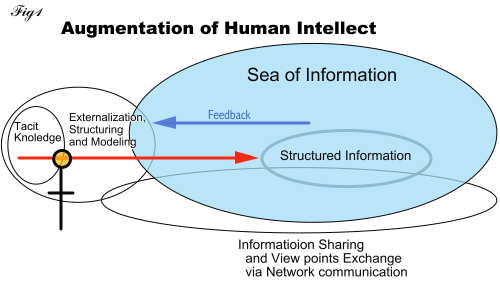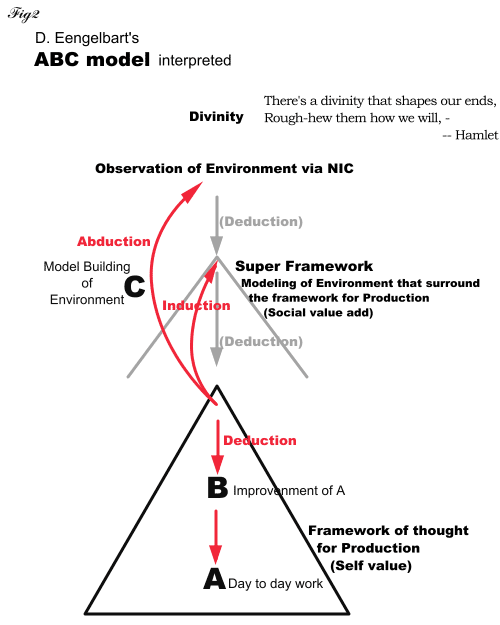Friday, August 26, 2005
Bootstrapping
Doug Engelbart
Foundation for Engelbart's experience-based and logically worked out strategy is an optimized bootstrapping approach for drastically improving on any organization's already existing improvement processes. Referring to an organization's principal work as an A-activity and to ordinary efforts at process improvement as a B-activity, he denotes bootstrapping as a C-activity, which is an improving of the improvement process. His paper Toward High-Performance Organizations: A Strategic Role for Groupware argues that highest payoff comes from engaging in that C-activity.
From Alan Kay:
This was in early 1967, and while we were pondering the FLEX machine, Utah was visited by Doug Engelbart. A prophet of Biblical dimensions, he was very much one of the fathers of what on the FLEX machine I had started to call "personal computing." He actually traveled with his own 16mm projector with a remote control for starting a and stopping it to show what was going on (people were not used to seeing and following cursors back then). His notion on the ARPA dream was that the destiny of Online Systems (MLS) was the "augmentation of human intellect" via an interactive vehicle navigating through "thought vectors in concept space." What his system could do then--even by today's standards--was incredible. Not just hypertext, but graphics, multiple panes, efficient navigation and command input, interactive collaborative work, etc. An entire conceptual world and world view [Engelbart 68]. The impact of this vision was to produce in the minds of those who were "eager to be augmented" a compelling metaphor of what interactive computing should be like, and I immediately adopted many of the ideas for the FLEX machine.
Another ski-lodge meeting happened in Park City later that spring. The general topic was education and it was the first time I heard Marvin Minsky speak. He put forth a terrific diatribe against traditional education methods, and from him I heard the ideas of Piaget and Papert for the first time. Marvin's talk was about how we think about complex situations and why schools are really bad places to learn these skills. He didn't have to make any claims about computer+kids to make his point. It was clear that education and learning had to be rethought in the light of 20th century cognitive psychology and how good thinkers really think. Computing enters as a new representation system with new and useful metaphors for dealing with complexity, especially of systems [Minsky 70].



from home.m04.itscom.net/hhomey/engelbart.html
Jerry posted yesterday about Bill & Steve creating standalone desktops, while Doug was focused on collaboration.
Call Marcello about this.
Foundation for Engelbart's experience-based and logically worked out strategy is an optimized bootstrapping approach for drastically improving on any organization's already existing improvement processes. Referring to an organization's principal work as an A-activity and to ordinary efforts at process improvement as a B-activity, he denotes bootstrapping as a C-activity, which is an improving of the improvement process. His paper Toward High-Performance Organizations: A Strategic Role for Groupware argues that highest payoff comes from engaging in that C-activity.
From Alan Kay:
This was in early 1967, and while we were pondering the FLEX machine, Utah was visited by Doug Engelbart. A prophet of Biblical dimensions, he was very much one of the fathers of what on the FLEX machine I had started to call "personal computing." He actually traveled with his own 16mm projector with a remote control for starting a and stopping it to show what was going on (people were not used to seeing and following cursors back then). His notion on the ARPA dream was that the destiny of Online Systems (MLS) was the "augmentation of human intellect" via an interactive vehicle navigating through "thought vectors in concept space." What his system could do then--even by today's standards--was incredible. Not just hypertext, but graphics, multiple panes, efficient navigation and command input, interactive collaborative work, etc. An entire conceptual world and world view [Engelbart 68]. The impact of this vision was to produce in the minds of those who were "eager to be augmented" a compelling metaphor of what interactive computing should be like, and I immediately adopted many of the ideas for the FLEX machine.
Another ski-lodge meeting happened in Park City later that spring. The general topic was education and it was the first time I heard Marvin Minsky speak. He put forth a terrific diatribe against traditional education methods, and from him I heard the ideas of Piaget and Papert for the first time. Marvin's talk was about how we think about complex situations and why schools are really bad places to learn these skills. He didn't have to make any claims about computer+kids to make his point. It was clear that education and learning had to be rethought in the light of 20th century cognitive psychology and how good thinkers really think. Computing enters as a new representation system with new and useful metaphors for dealing with complexity, especially of systems [Minsky 70].



from home.m04.itscom.net/
Jerry posted yesterday about Bill & Steve creating standalone desktops, while Doug was focused on collaboration.
From: Jerry Michalski
Reply-To: sociate-talk@freelists.org
To: sociate-talk@freelists.org
Date: Aug 25, 2005 10:05 PM
Subject: [sociate-talk] The chasm from Engelbart to Jobs and Gates
Reply | Reply to all | Forward | Print | Add sender to Contacts list | Trash this message | Report phishing | Show original
While reading John Markoff's excellent history of Silicon Valley's contributions to computing and the Internet, What the Dormouse Said, I was struck by the yawning chasm that separates Doug Engelbart's original vision of augmented collaboration from the notably personal computing visions elaborated by Bill Gates and Steve Jobs.
Early on, Gates produced MS-DOS, a fragile little operating system that hardly worked unless you bought more software from other companies. Remember memory management? NetBIOS? Novell's Netware?
 Jobs then took the highly networked visions created at Xerox PARC and somehow turned out a brilliant, but completely isolated little anthropomorphic machine. For some time, he didn't want it to have a hard drive, a network or a larger/color monitor. Sheesh.
Jobs then took the highly networked visions created at Xerox PARC and somehow turned out a brilliant, but completely isolated little anthropomorphic machine. For some time, he didn't want it to have a hard drive, a network or a larger/color monitor. Sheesh.
Gates then copied that. A mere decade later. (Windows 3.1 doesn't really count; Windows 95 achieved parity, but only because the Mac OS had somehow become frozen in time.)
We're still stuck with the (my) desktop metaphor, and on top of that, with mere personal productivity applications. We ship one another bulky Word and PowerPoint files, praying the versions don't get mixed up in transit. Those documents are too large for collaboration, and their proprietary formats don't allow the linking and remixing needed for creativity.
Other people? Other places? They're over there, on the H: drive or in the "collaboration" application.
Why have these magical platforms neglected our social nature for so long? Why are these features still being glued on as afterthoughts, like antlers on a jackalope? Can't we loosen up, move things around a bit so that collaboration, annotation, search and linking are always at hand, for every object, as native functions of every window?
Doug had a fantastic vision, one he may have clung to too tightly as implementation details mounted (this Markoff's book points out well). But the social nature of work was implicit in the vision. That little essential bit got ignored.
Now, happily, social software is in. Doing things together is cool. Emergent crowd behavior gets oooohs and aaaaahs and some decent research funding. About time.
By the way, a similar cognitive gap opened when Marc Andreessen and his buddies at NCSA added images and other media capabilities to their Mosaic browser, but didn't implement the writeable side that Tim Berners-Lee had intended the Web to have. So the Web became something browsable, more like TV and magazines, rather than writable.
Wikis in particular are helping make the Web writable again, which makes me smile.
It really is time we rethink the computers we're using. They spend way too much time churning to do things we don't need them to do -- don't get me started on the many lovely DRM features being built into the next generation platforms -- and not enough just doing what we really need.
Early on, Gates produced MS-DOS, a fragile little operating system that hardly worked unless you bought more software from other companies. Remember memory management? NetBIOS? Novell's Netware?
Gates then copied that. A mere decade later. (Windows 3.1 doesn't really count; Windows 95 achieved parity, but only because the Mac OS had somehow become frozen in time.)
We're still stuck with the (my) desktop metaphor, and on top of that, with mere personal productivity applications. We ship one another bulky Word and PowerPoint files, praying the versions don't get mixed up in transit. Those documents are too large for collaboration, and their proprietary formats don't allow the linking and remixing needed for creativity.
Other people? Other places? They're over there, on the H: drive or in the "collaboration" application.
Why have these magical platforms neglected our social nature for so long? Why are these features still being glued on as afterthoughts, like antlers on a jackalope? Can't we loosen up, move things around a bit so that collaboration, annotation, search and linking are always at hand, for every object, as native functions of every window?
Doug had a fantastic vision, one he may have clung to too tightly as implementation details mounted (this Markoff's book points out well). But the social nature of work was implicit in the vision. That little essential bit got ignored.
Now, happily, social software is in. Doing things together is cool. Emergent crowd behavior gets oooohs and aaaaahs and some decent research funding. About time.
By the way, a similar cognitive gap opened when Marc Andreessen and his buddies at NCSA added images and other media capabilities to their Mosaic browser, but didn't implement the writeable side that Tim Berners-Lee had intended the Web to have. So the Web became something browsable, more like TV and magazines, rather than writable.
Wikis in particular are helping make the Web writable again, which makes me smile.
It really is time we rethink the computers we're using. They spend way too much time churning to do things we don't need them to do -- don't get me started on the many lovely DRM features being built into the next generation platforms -- and not enough just doing what we really need.
Call Marcello about this.
